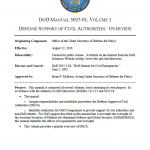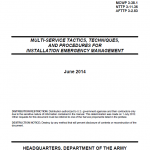
This manual is composed of several volumes, each containing its own purpose. In accordance with the authority in DoD Directives (DoDDs) 5111.13 and 3025.18 the manual assigns responsibilities and establishes procedures for Defense Support of Civil Authorities (DSCA) and identifies authorities for DoD Components to provide support of civil authorities and non-DoD entities. For DoD support described in this manual that is not under the oversight of the Assistant Secretary of Defense for Homeland Defense and Global Security (ASD(HD&GS)), this manual identifies the offices of responsibility and oversight.

